Very rarely in my PPC life do I bring up the subject of attribution with clients, colleagues, or industry friends without seeing a look of pain cross a face that may have been perfectly congenial a moment ago. Much teeth-sucking and drink sipping ensues when the difficult topic of attribution enters the discussion.
We all fear we aren’t properly attributing our conversions to each platform, be it paid or organic. Namely, this frustration stems from 3 main factors:
- The customer journey is more complex than ever before. Customer journeys are not linear, between multiple devices, long sales cycles, and mere impressions (view-throughs) that may or may not have encouraged the user to convert. Facebook and YouTube now have brand-lift studies to close some of the gap, but the cost for these kinds of prove-the-brand-is-improving tests is often beyond the financial reach of smaller brands.
- There are more attribution platforms, both free and paid, offered in the digital marketing space. And we have no idea which one has the true data. We are at full saturation and everyone has a solution, including the new Amazon Attribution Beta, and Facebook Attribution, which became available to all advertisers in October 2018 after testing for a year in beta. Third-party attribution vendors crowd the market too, and marketers have decision fatigue.
- Getting any attribution source to play nice and line up with another seems like an impossible task, in a world of walled gardens. In the /r/PPC subreddit, it’s common to see cries for help every week regarding two reporting sources misaligning – most commonly, Google Ads and Google Analytics failing to align.
So what can we do to make more educated attribution choices? There are a few main things every marketer must take into account.
1: Pick Your Windows Wisely
Aligning your attribution with the truth starts with the windows you choose in each ad platform. A conversion window is a defined period of time in which a publisher can claim that a click or impression led to a conversion (be it a lead, app install, purchase, or otherwise.) You can set your conversion windows in every single ad platform except Google Analytics, which has reports specifically built for comparing windows.
The Google Analytics Time Lag report is a good place to start if you want to understand how long it takes a user to move from consideration to conversion:

You can use the Path Length report in Google Analytics and segment by specific goals:

Which window do you choose? 30-day impression, 7-day click? 7-day impression, 1-day click? There are several ways to find out! Your window will depend on:
1) The Nature of your Business
- You’ll want to pick longer windows for your conversion settings when your products are more expensive, high-consideration products such as software as a service, home remodeling, etc. Comparison shoppers take their time. This is where tracking different movements of users from trial to paid subscription, email signup to quote request are vital so you can track the entire journey of the user. Each movement – from a potential customer learning about your brand to putting money in your pocket, must be tracked in all the platforms you can, from Facebook Analytics Event Source Groups to training salesmen to properly label leads in your CRM software.
- You’ll want to set your windows to a short period of time if most of your customers are buying with their gut. This is true for those random products you buy from Instagram without much thought. Pony-Os Instagram ads, I’m looking at you! (I swear, it felt like a good purchase in the 7 minutes it took for me to consider it, toss it in my cart, and purchase it!) If your windows are short, you’ll want to align them with the settings of each and every platform you use, as well as your reporting software.
2) Advertising Channel
- You’ll want to consider the purpose of the advertising channel. Are you advertising for a conversion result, or a lift in brand awareness? For example:
- Search tends to be a low-funnel channel and results in more direct conversions due to search intent.
- Social channels tend to suffer from misguided budget cuts, due to marketers not recognizing that these channels are often first-touch or awareness-based. For example, we have a B2B client who runs LinkedIn campaigns to grow brand awareness among a highly specific, professional audience. Just having these high-quality audiences visit their site is improving the quality of their retargeting audiences and will be worth the investment in the long run. But by no means do we treat these campaigns as a conversion-producing, direct channel.

2: Learn How Different Platforms Attribute Conversions Differently
For Google Ads, the Attribution Playbook is a good place to start. Google also is helpful enough to provide an attribution tool that allows you to compare different search attribution models before taking the plunge and adjusting your conversion attribution settings:

If you haven’t picked through the Google Attribution modeling tool in a while, you’re missing out. You can model cross-device activity, paths and time-lags (similar to what you’ll find in Google Analytics), and first and last click analysis, among other handy tools to slice and dice your data.
Most marketers agree that “Last click” or “Final click” attribution does not even begin to tell the truth and it is no longer recommended. Industry leaders agree, and this Invoca blog on how Google last-click attribution leads marketers astray clearly lays out the reasons why.
It’s easy to look up how each platform uses attribution modeling. A quick search turns up these resources:
- How Facebook decides which actions attributed to your ad
- About the LinkedIn Ads attribution model
- How to configure Microsoft conversion attribution
3: Appreciate Lag & LTV when Testing a New Channel or Campaign
One of the biggest mistakes that marketers make is deciding a strategy isn’t working too soon. When testing, make sure you have a specific statistical significance you’re shooting for or even a time period in which you’re willing to stick it out and test. If you need a refresher, this post on calculating statistical significance from our own Carrie Albright is a great place to start! Once you have concrete goals, it will make your analysis a lot easier, although patience is always needed when testing any new channel or initiative.
4: The Source of Truth is Beyond the Platforms: It’s in Your Sales Data
This should go without saying. But I’m going to say it anyway! Your salespeople are sure to know more about lead quality than your marketing team. Train your team to gauge lead quality in their CRM. If you’re an e-commerce company, use internal resources to understand revenue and lifetime value. It is vital to have complete clarity between each marketing dollar spent and trendlines of success in your company.
As an agency, Hanapin is always pushing to get more internal information and reporting transparency because if leads do not lead to revenue, we want to know about those failures as quickly as possible. The same for successes – Have regular meetings between all teams to make sure your marketing dollar is balanced between first-touch and bottom-funnel, brand and non-brand. The ultimate source of truth will be money in your pocket. For new clients, often the process of clarifying attribution is working hard to ensure all tracking flows smoothly from campaigns into whatever system is being used to measure success, be it Bizible, HubSpot, Marketo, Salesforce, Pardot, Shopify, BigCommerce, or any number of propriety systems.
The Best Time to Fix Your Attribution was Yesterday. The Second Best Time is Today
We are having more conversations with our clients about attribution every day. This is natural. The rise of automated systems within platforms (Google’s automated bidding settings, Facebook’s mysterious way of using their algorithm to find potential customers) is going to depend on your attribution settings being correct. So if they aren’t correct, fix them today. Look at your attribution windows. Check your settings. Talk to your agency, and get your sales reports in line.
The marketing stack is more complex today than it was yesterday. But there is no time like the present to evaluate your attribution within and without your digital marketing platforms. Review often, and review thoroughly. And make use of absolutely free tools like Facebook Attribution, which uses advertisers in similar verticals and products in the same price points to inform your attribution choices, and Amazon Attribution – they’re free and comprehensive, why not use them?
I hope this blog has given you some places to start auditing your own attribution settings and systems to cut through to the truth and pave the way for a more informed marketing strategy.




